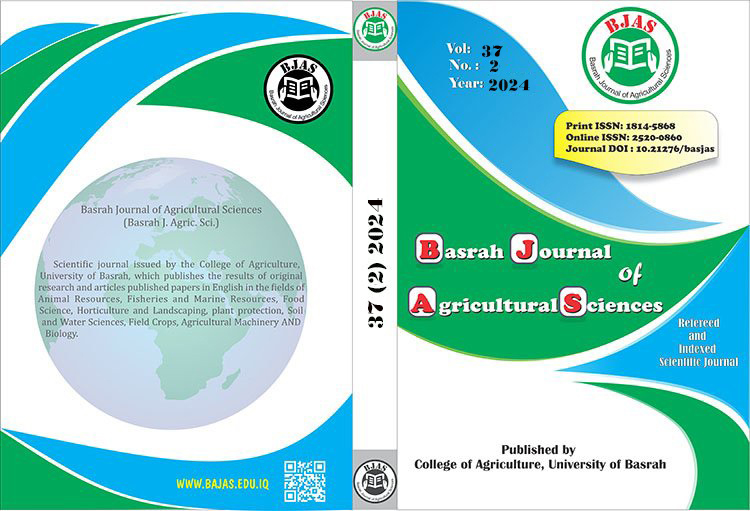Abstract
The most popular and efficient way for fertilization is soil application which needs to be applied in more significant quantities. Nevertheless, foliar fertilization is more practical and cost-effective in some situations. The main diagnostic methods for crop nutrients are foliar and soil fertilization tests to improve crop growth responses. Due to insufficient fertilizer application, particularly when utilizing the usual approach as a soil fertilizer addition, soil degradation will continue and become more expensive and impacting plant growth. To evaluate the influence on the maize vegetative growth, several NPK fertilizer levels were applied using foliar spraying, soil application and their combination treatments at different dosages. Experimental design was factorialal arrangement in a complete randomized block design (CRBD) with three replicates. Data analysis using Genstat softwar (Discovery edition3). The droplet properties such as volume median diameter, droplet deposition, uniformity, and coverage percentage are influenced by the layer of the plant canopy. In addition, the main growth characteristics of maize plants were measured. The upper layers of the plant canopy are the more in the spray deposition (0.529 µl.cm-2), but the higher coverage percentage (33.36%) and the better deposition uniformity (5.54%) obtained in the bottom layers of the maize canopy. The findings demonstrate also a considerable increase in plant height, leaf number, leaf area, stem diameter, wet weight, dry weight, and percentage of N content in plants treated with foliar application and soil fertilization simultaneously (47.52cm, 14.98 leaf.plant-1, 8077, 6.06cm, 52.13gm, 14.31gm, and 2.71%) respectively. The findings imply that soil fertilization and foliar spraying can be used to enhance maize growth.
Keywords
Droplet characteristics
Foliar spraying
Soil fertilizer
Zea mays L.
Abstract
الأسمدة التي تطبق بكميات أكبر، فإن استخدام التسميد الارضي هي الطريقة الأكثر شيوعًا. ومع ذلك، فإن استخدام التسميد الورقي يعد أكثر عملية وفعالية من حيث التكلفة في بعض الحالات. هناك طرق متعددة في اختبارات التسميد الورقي والارضي واستجابة نمو المحاصيل لها. وبسبب عدم كفاية استخدام الأسمدة المضافة خلال زراعة المحاصيل، خاصة عند استخدام الطريقة المعتادة كإضافة التسميد الارضي، مما سيؤدي الى المزيد من تدهور التربة فضلا عن الكلفة العالية، مما يؤثر على نمو النبات. ولتقييم هذا التأثير على النمو الخضري لمحصول الذرة، تم إجراء العديد من التوليفات من الأسمدة المركبة باستخدام الرش الورقي والتسميد الارضي ومعاملاتهم المركبة و بكميات مختلفة. استخدمت التجربة العاملية في اسلوب القطاعات العشوائية الكاملة (CBRD) في ثلاث قطاعات باستخدام برنامج Genstat. أظهرت النتائج تأثر خصائص القطرات كتوسط القطر الحجمي، وترسب القطرات، والانتظام، ونسبة التغطية بطبقات المجموع الخضري للنبات. كانت الطبقات العلوية من النبات هي الأكثر نصيبا في ترسيب الرش (0.529 µl.cm-2). كلما زادت نسبة التغطية (33.36%) كان انتظام الترسيب الذي تم الحصول عليه أفضل في الطبقات السفلية للذرة (5.54%). كما أظهرت النتائج أيضًا زيادة كبيرة في متوسط طول النبات، وعدد الأوراق، وقطر الساق، والوزن الرطب، والوزن الجاف، ونسبة محتوى النيتروجين (47.52، 14.98 ورقة.نبات-1، 8077، 6.06 سم، 52.13غم، 14.31غم، و 2.71% على التوالي في النباتات المعاملة يالتسميد الورقي والارضي معا عند اقصى كمية مضافة من الاسمدة المركبة. لذا فان نتائج الدراسة اشارت إلى أنه يمكن استخدام التسميد الارضي والرش الورقي معا لتعزيز النمو الخضري للنبات بشكل افضل.
Keywords
خصائص القطرات، الرش الورقي، التسميد الارضي، محصول الذرة الصفراء.
